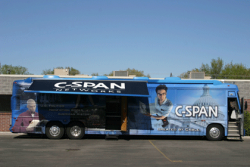C-Span Network visits Kearns-Saint Ann School

SALT LAKE CITY — Students and teachers were invited aboard the award-winning C-SPAN Civics Bus as their national tour came to Utah. The 45-foot mobile production studio and demonstration center traveled to Salt Lake City May 8, making stops at Kearns-Saint Ann School, the Columbus Center, and East High School. Comcast Cable hosted the C-SPAN Civics Bus’ visit to Salt Lake City. Students and teachers had the chance to tour the bus during its stops and learn about the many resources C-SPAN offers, including the network’s education website, C-SPAN Classroom (www.c-spanclassroom.org), a free membership service for educators with downloadable video clips; the C-SPAN Video library (www.c-spanarchives.org); and C-SPAN’s coverage of the Obama administration. This year marks the bus’ 16th year on the road. With a new exterior design wrap and an interior with the latest television production equipment, the C-SPAN Civics Bus continues to travel the country, bringing the world of public affairs to life. Celebrating its 13th anniversary, C-SPAN, the political network of record, was created in 1979, by America’s cable companies as a public service. C-SPAN is currently available in 90 million households, C-SPAN2 in 82 million households, and C-SPAN3 in more than 13 million households nationwide. Rodee Schneider, a marketing representative traveling with C-SPAN for two years said, "There are three cameras on board, and this is our traveling television studio. We have had presidential candidates, former President Bill Clinton, former President George W. Bush, and big name authors on board. It is a way for us to do some interviews on the road." Schneider explained to the students how the cameras operate, how the technicians operate them, and how they broadcast live from the road. "What we do is broadcast our government such as senators and congressmen," said Schneider. "There are three branches of government: the legislative branch, the executive branch, and the judicial branch. That is who we broadcast. "Why would we want to do that," Schneider asked the sixth and seventh grade classes at Kearns Saint Ann School. "If you are watching the government in action on our network, this is what it would look like." Schneider showed the students a clip of the Congress in action, and asked them if they would like to watch it, to which they answered, not really. "Sometimes it is really fascinating to watch, and sometimes it is not," said Schneider. "The government is not always exciting, but we broadcast it because the people of America want to know what our government is doing. "Who elects these people?" asked Schneider. Michael Brown, a sixth grader, answered, "The American people." "Should you be able to see what Orin Hatch, Rep. Senator of Utah is doing in Washington, D.C.?" asked Schneider. "Our philosophy is that we should be able to see if we agree with what he is doing, or disagree. Not only should you be able to see, even though it may not be that exciting to watch, you should be able to see it without a newscaster chiming in with commentary or other news reports. This way you can see it and make up your own mind about it. "How do you find out about what is going on in the world?" asked Schneider. Brown answered, "By watching television or reading about it." Schneider asked the students about their school newspaper and what types of things they put in the paper, how they figured out what they wanted to focus on, and what they could talk about. He showed them a film clip of two well-known authors yelling at each other that other networks wanted to use. Schneider also explained to the students how they will just use a minute or less of the clip for a sound bite to illustrate what was going on, whereas, C-SPAN captured the whole program. "We take this bus to a lot of book festivals and make stops at high schools," said Schneider. "We shoot programs that are live and sometimes we will tape them. We visit the House of Representatives and the Senate when they are in session, we will always have that on. Sometimes when the president is giving a press conference, we will tape that and broadcast it later in the day. C-SPAN has the House of Representatives, the congressmen, and C-SPAN2 has the Senate. Each state has a different number of congressmen depending on how many people you have in each state. Each state has two senators. "C-SPAN3 is a channel that carries other committees such as the case of baseball player Manny Ramirez who was suspended for the use of steroids," said Schneider. "We broadcast a subcommittee hearing about steroids in baseball and how they set a bad example for young kids, and how they need to root out the problem. C-SPAN also broadcasts history. "The bus goes to all 50 states including Hawaii and Alaska covering different events, such as the elections," said Schneider. "But the vast majority of our broadcasts come from Washington, D.C. This is one place you can get a lot of news and information." For more information about C-SPAN, visit www.c-span.org.
© Copyright 2024 The Diocese of Salt Lake City. All rights reserved.

Stay Connected With Us